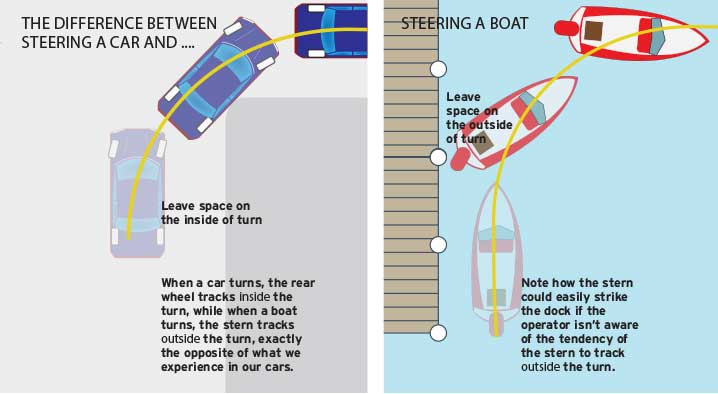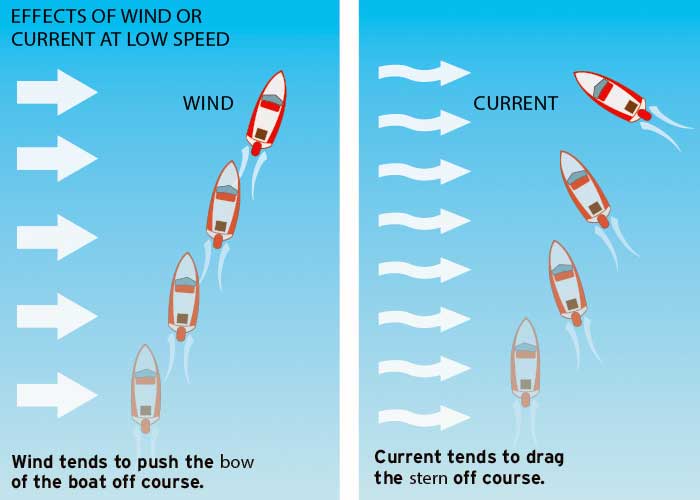Advertisement
Even experienced boaters can benefit from these four smart tips to improve their steering control.
Many boaters, myself included, were taught to use the engine as the primary way to overcome the environment, to power through adverse situations. This way of thinking will sooner or later break your boat, or get someone hurt. A competent operator should be able to handle their boat in close quarters using wind and current, and be able to safely come alongside, back their boat, turn in a narrow space, and certainly dock their boat. That's the kind of training that boaters receive by attending a hands-on boating course taught by U.S. Sailing, the Power Squadrons, the National Safe Boating Council, and local boating schools across the country. To find a course near you, visit our BoatUS Foundation website. A good one-two punch would be to take a hands-on course such as this, as well as an online course from the BoatUS Foundation.
Tip
There are four basic skills taught by instructors certified by the National Safe Boating Council; in this article we'll focus on the first one, steering-wheel control. In upcoming issues, we'll focus on three other important skills.
Steering Wheel Control
Over-steering and over-correcting are common problems. We must know whether the wheel is straight or turned and, if turned, which direction and how far. There isn't room for guessing and making corrections if the boat doesn't turn the direction anticipated.
The Difference Between Steering A Car and Steering A Boat

When a car turns, the rear wheel tracks inside the turn, while when a boat turns, the stern tracks outside the turn, exactly the opposite of what we experience in our cars. Note how the stern could easily strike the dock if the operator isn't aware of the tendency of the stern to track outside the turn.
We're all used to driving a car. How much different can steering-wheel control be on a boat? Well, hugely different, in reality, and it can get you in trouble if you don't recognize the distinction. Cars steer from the front while boats steer from the stern. Boats pivot, cars don't. When you steer a car, the front tires turn the front of the car, and the rest of the car follows. Take a corner too tightly and the inside rear wheel hits the curb. When you steer a boat, the rudder, outdrive, or outboard swivels at the stern and directs the thrust in a way that pushes the stern in the opposite direction. Because of this, when taking a corner in a boat, your boat needs room on the OUTSIDE of a turn — the exact opposite of a car. This difference isn't too noticeable on open water, but critical in close quarters.
Effects Of Wind Or Current At Low Speed

Wind tends to push the bow of the boat off course. Current tends to drag the stern off course.
Two forces steer a boat while moving forward (making headway) — the wash or thrust from the spinning prop, and the rudder effect of the drive or rudder slicing through the water. When making headway in forward gear, prop wash and rudder effect work together. Shifting into neutral subtracts prop wash, but the boat's headway through the water allows the drive or rudder to keep working, so some steering control is retained. The same holds true in reverse gear (sternway). The faster the boat moves through the water, the greater the steering force of rudder effect. When operating at slow speed, your boat will handle better when the prop is turning. So, timing is important when you're trying to steer and shift gears at the same time. Shift too soon or turn the wheel too late (or vice versa) and control may be lost.
Talk The Walk
Another factor that affects how your boat moves through the water is "prop walk," a sideway force at the stern caused by the spin of the prop. Direction of the walk is dependent on which way the prop spins. The spin gives the boat a tendency to turn slightly, instead of going straight — and may cause your boat to lean one way or another at high speed. Prop walk is more noticeable in reverse than in forward gear, and more pronounced on inboard vessels. Viewed from behind, a right-hand prop spins clockwise in forward gear, and a left-hand prop spins counterclockwise. When a right-hand prop is in forward gear, it will "walk" the boat to starboard; in reverse gear, it will walk the boat to port. Likewise, a left-hand prop in forward gear will walk the boat to port, and walk it to starboard in reverse gear.
How To Tell If You're Moving ...

Look through a nearby fixed object at the background. If the background is moving, so are you.
Prop walk can be put to good use when docking. When possible, it's an advantage to approach the dock on the side where the planned maneuver will walk the stern to the dock. If you can't do this, you'll need to take that into account and adjust how much you steer. But before you take a boat into tight quarters, make sure you've gotten a working understanding of the following techniques.
Centering The Wheel
Start by figuring out the range of the wheel, which is how many times it takes to turn the wheel from hard-to-port to hard-to-starboard. Turn the wheel all the way to one side or the other, then turn hard the other way, counting the number of turns it takes. Divide the number of turns in half and remember that number. So if it takes six turns to get from one side to the other, three turns should center your wheel from either side. It's very important to know when your wheel is centered, especially with inboard or sterndrive boats where you can't see the drives. It's also a handy practice if you're asked to take the helm on an unfamiliar boat.
Advertisement
Steer A Straight Course
Now that you know how to center the wheel, the next technique is steering straight. Looking at the wakes of many boats, you'll often see a serpentine path, because people are over-steering. To practice:
- Center the wheel.
- Shift into forward gear at idle speed.
- Aim for a distant object, watching the bow.
- When the bow drifts to one side, make quick, short pulses with the wheel in the opposite direction then re-center the wheel.
Many people tend to over-correct when steering and, instead of staying on course, drift too far in the other direction because they hold the turn too long. The key is to use short corrections, and when the boat initially begins to turn in the desired direction, re-center the wheel. As you practice steering straight, you can continually find new objects to use as a target and see how the boat behaves differently at different speeds.
Setting The Wheel
Make sure the wheel is in the desired direction and position BEFORE shifting into forward or reverse gear. This helps reduce your turning radius, making your turn more efficient — useful when operating in close quarters, where you might not have the ability to turn without properly setting the wheel. For many boats, you should be able to do a 180-degree turn in little more than a boat length if you set the wheel, and do so in conjunction with proper gear shifting.
